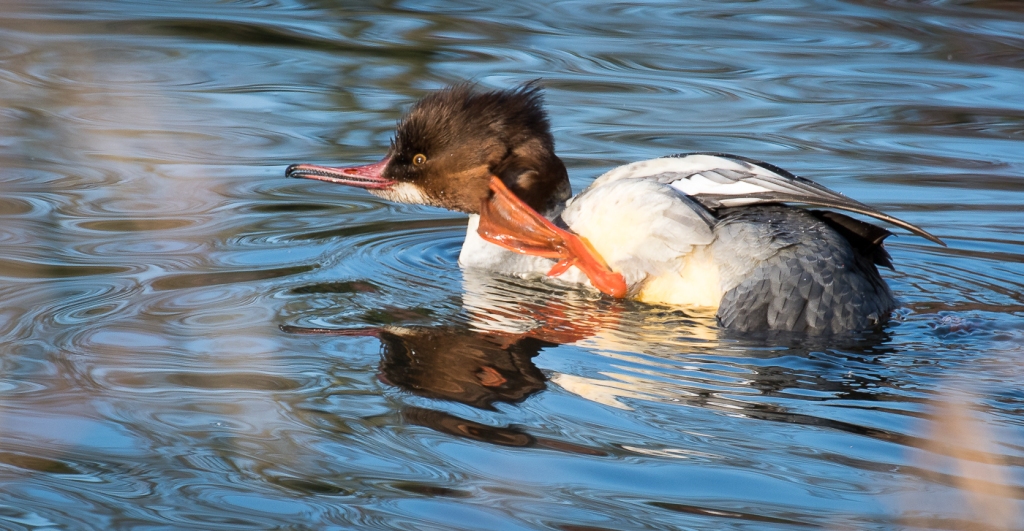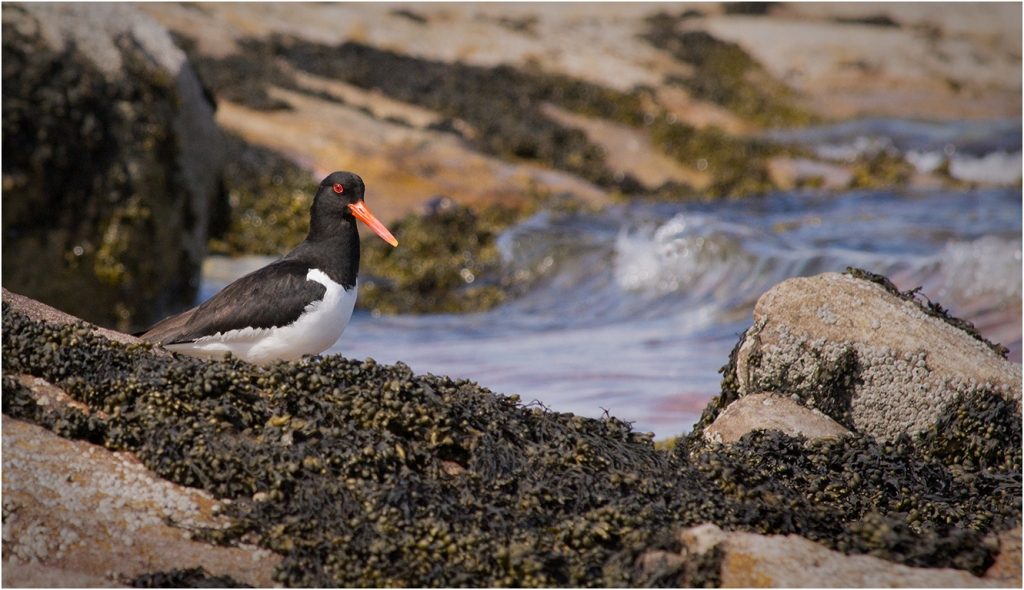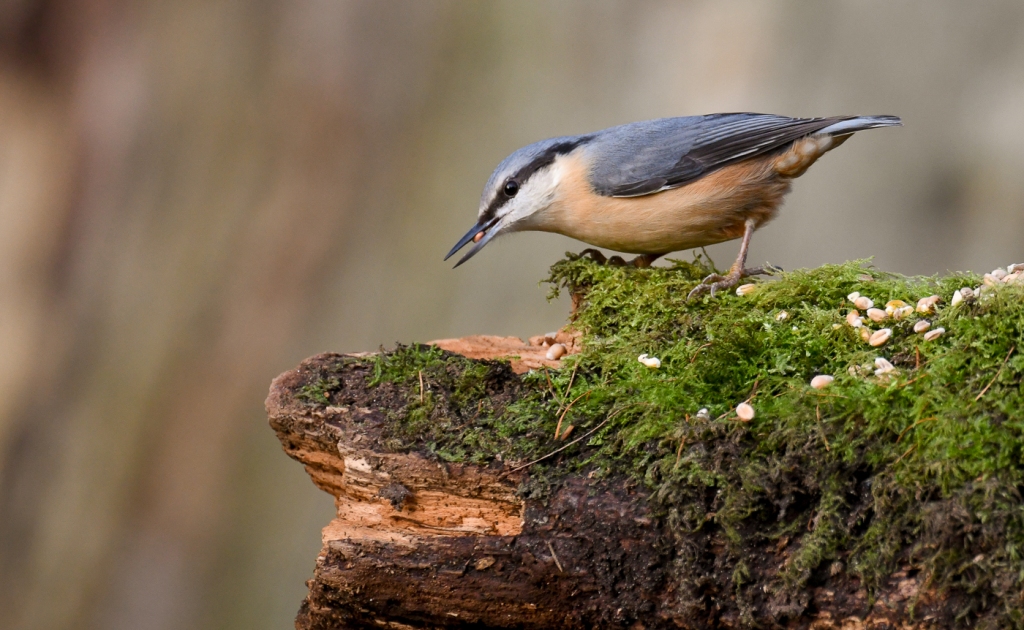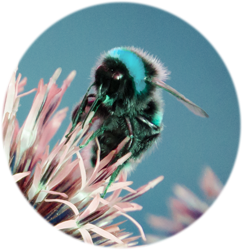Generally, a nature shot focusses on a particular subject, perhaps a bird, an insect, or a flower. To get a good image, it’s best that the subject in sharp focus, and often the use of automatic camera focussing is essential.
But even if it is a sharp image, there are some other strategies to help ensure the viewer will not simply glimpse at it and move on to the next image, but instead to linger and examine the image more closely.
The opening image above is the most common bird around here, a female blackbird, normally just seen as just a brown bird scuttling across a lawn. Here it’s drawn to food and I’m quite happy with the image because the light is so good; the low winter sun has highlighted the detailed feathering that you don’t always get a chance to see. And I was also lucky to be able to choose a light background behind it’s head to make this a focal point.
So getting good light on the subject is my first requirement, and here’s another example of a female goosander. In addition to that great winter sunlight, the foot out of the water takes it away from the standard portrait shot.

Now, plants aren’t going to fly off anywhere soon, so there’s time to compose the image. One compositional idea is to incorporate a diagonal. The fungi below was a prime example. No good light here, so a little flash was used to help it out.

My next shot of catkins uses a diagonal too but I’ve also tried to use a clean blurred background to ensure the subject stands out. I find I’ll move right around the subject to try and get as clear a background as possible.

I sometimes worry that a clear background makes the image seem a bit unnatural because its not what you are so aware of in nature, but it certainly highlights the subject.
Sometimes I’ve taken a wider image to take in some of the environment around the subject. So, next I’ve included an image of an oystercatcher (one of my favourites) taken in its ‘normal’ environment. But with the shallow depth of field from the telephoto lens, the background and foreground are both blurred, putting more focus on the bird itself.

When the subject takes up only part of the image, I’ll try to use that old ‘Rule of thirds’ – so the the eye naturally settles on the point of interest. Just like the oystercatcher, I’ve chosen that type of composition with the nuthatch in the image below, though you’ll see I’ve used that smooth blurred background again.

Sometimes the background is so complex and cluttered, it makes it really hard to isolate the subject for the viewer. I was up at RSPB Lochwinnoch, behind a fence style hide when a cock pheasant came wandering right into view (they must be used to visitors). The ground cover was a tangle of twigs and branches, and quite distracting. Nothing wrong with the image but with a bit of post-processing, I darkened all the bright twigs and provided a strong vignette. I think it improved the image but I’m not quite so sure of this one.

Sometimes however, nature will provide its own vignette. In the shot below, the sun is coming through the trees and, by taking up the correct position, I could pick out the black-headed gull (in winter plumage) lit up from behind. That low winter sun on the iced-up pond seemed to work for me.

So I’ll close with an image that uses several of these ideas. It’s an image of an common ox-eye daisy. It’s got good sunlight on the flower while the background is in shade, and because of the telephoto lens, that background is fairly smooth and blurred. I placed the flower one third down in the frame. On top of that I’ve added a more subtle vignette in post-processing, such that I feel the daisy couldn’t stand out any more. I’m now not sure whether I’ve moved this image from being a nature shot into a more artistic image. I guess it doesn’t really matter, as long as I like it.

Thanks to Patti, for setting up the idea of a post on focus. This week Patti hosted the Lens-artists Photo Challenge – Focus on the Subject, which was a great prompt for me to put together these images.
I hope you like them too and if you see some of my nature shots in other posts, I’m sure you’ll now be spotting these techniques every time.



Excellent response to the focus challenge. I am often taking photos of moving horses so the auto focus is a must. I liked all your work with these photos and thank you for sharing the decisions you made with each of the photos.
LikeLiked by 1 person
Thanks, Anne! Glad you appreciated them!
LikeLiked by 1 person
Ahh. Nay-cha (nature). How diverse. What a strange blue marble we are, floating like a grain of sand in an immense dark sea. Well done.
LikeLiked by 1 person
What a remarkable series, James! I love these bird shots, they are sharp and clear. Thank you for this wonderful focus on nature lesson.
LikeLiked by 1 person
Thanks Amy!
LikeLike
Hi, James. This is a fabulous post with your beautiful images and clear explanations of the purpose of your shots and how you created them.
LikeLiked by 1 person
Thanks Patti! It was a good topic in the first place.
LikeLiked by 1 person
😀
LikeLiked by 1 person
Great photos, especially your use of shallow depth of field. Personally I think the edit on the pheasant shot works well, but that may be because it’s the sort of edit I would probably choose to do myself!
LikeLiked by 1 person
Thanks, Sarah. The pheasant is a bit sharper a vignette than I usually use. I prefer them to be much more subtle
LikeLiked by 1 person
I know what you mean but I think it works!
LikeLiked by 1 person
Ah, what a treat every specimen here…Thank you for the entertainment!
LikeLiked by 1 person
Thank you!
LikeLiked by 1 person
Love the daisy!!!
LikeLiked by 1 person
Thanks! It’s a favourite of mine.
LikeLiked by 1 person
As always James, your images are exquisite. This one is literally a class on how to optimize the use of focus to draw the viewer’s eye. Superb
LikeLiked by 1 person
Thanks Tina! I appreciate your kind comments.
LikeLike